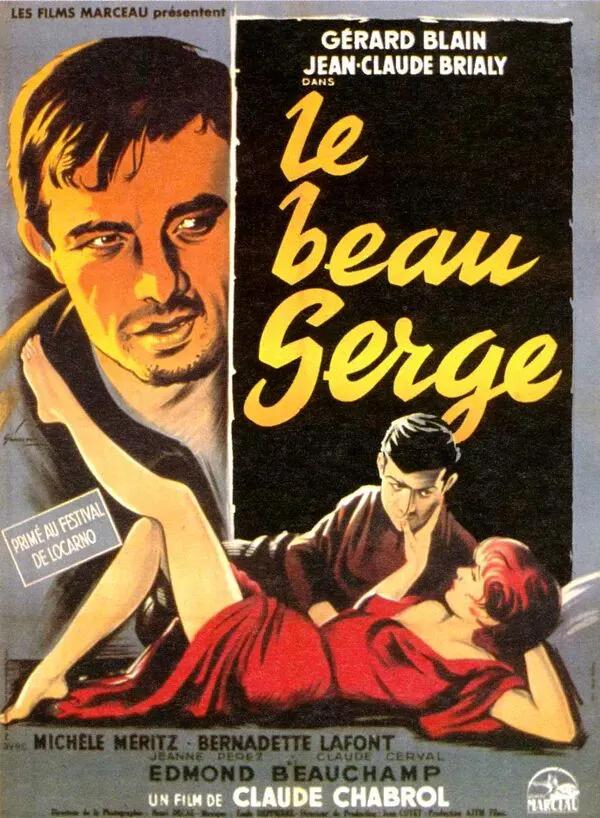In 1958, Chabrol's "Pretty Selki" appeared on the screen of the film with a novel gesture, and the Express reporter Lang Sovaz Giroud used the "New Wave" for the first time to describe the film, and since then the "New Wave" film has become a wave that has swept the film industry along with the french directors of the same batch.

The newness of the "New Wave" was its greatest feature, and the directors opposed the so-called high-quality films that were popular at the time, that is, commercial films that followed the popular preferences. Under this tradition, the New Wave opened up a new path to influence world cinema. Truffaut's "author's theory" is essentially a director-centered theory, which is still reflected in many films today.
1959 was a happy year for the "New Wave". At the Cannes Film Festival, Truffaut's Four Hundred Under won the Best Director Award, and Aaron René's Love of Hiroshima won the Jury Prize, while they came from the Film Manual School and the Left Bank Faction, respectively.
There is a line in "Love in Hiroshima" that is very famous:
I met you
I remember you
The city is born to fall in love
You were born to fit my body
The director is Arun Renai, and the screenwriter is Duras, who is also a Left Bank faction, and the left-bank works are more political than the film manual school's untouched politics. "Hiroshima Love" is about a French actress who goes to Hiroshima, Japan to shoot a film to promote peace, during which she meets a local construction engineer and embarks on a brief extramarital affair despite the identity of their existing partners.
More than a decade had passed since the Hiroshima nuclear explosion, and the invisible scars had been hanging over the people of Hiroshima, and the particularity of Hiroshima reminded the actress of her love story with a German occupation army when France fell. Similar to the Hiroshima nuclear explosion, that love is like a "little boy" in the heart of the actress, and the feelings with different political positions are doomed to a good end, and eventually become a ruin that she does not dare to set foot in her heart.
As Aaron René's film debut, it has begun to show a very personal style of stream-of-consciousness expression, coupled with Duras's previous strong literary meaning, focusing on exploring the entanglement of the inner world and the imperfections of the subconscious. There are not many scenes in the film, erotic scenes, conversations and memories intersect, new encounters trigger old wounds, shaved hair and locked in cellars for falling in love with the invaders, and an immoral love that is not understood by anyone emerges.
Just after the actress's love was completely destroyed, Hiroshima was also destroyed by the atomic bomb. One is even in the pain of expecting the war not to end for love, and the other has avoided the nuclear explosion but chose to avoid the war.
As the times changed, the war was attached to the ruins and became a piece of exhibit in the museum. The land washed by the torrent of history will eventually grow flowers, and the shattered ruins will be replaced by high-rise buildings. Two people have their own possible happy families, but just like the parting of the erotic pleasure at the end of the film, the camera slowly pushes towards the actor's face, the audience slowly approaches the character's heart, the closer you get to a person's heart, the more you will find its heaviness, and forgetting is more difficult than imagined.
At the beginning of the film, the two people are entangled for thirteen minutes, and the erotic scene is interspersed with the scene of Hiroshima after the war, and the gravel sprinkled on the two symbolizes the dust after the explosion of the Hiroshima nuclear. Two broken souls are intertwined, and their suffering comes from the cruelty of war. Some people say that the trip to Hiroshima is a psychotherapy for actresses, which is not a cure for the male protagonist.
At the end of the movie, I think the actress really fell in love with the architect, otherwise she wouldn't have struggled so much between going and staying. The man who helped her say the shackles in her heart also seems to occupy a wasteland, and it is precisely because of the re-exposure of the scar that the actress chooses to leave, when the love behind becomes heavy, separation is the best choice.
The tree trunk in the shot splits the scene in two, with the architect on the right and the actress and the locals who come to talk to her on the left, who speaks Japanese English and babbles at the actress, paying no attention to her absent-mindedness. Maybe this is the scene where the architect and the actress met, but none of this mattered, the architect became another scar in the actress's heart since her first love. The heavy past shared with each other, like the trunk of the tree standing between the two people at this time, has become a permanent estrangement, and the end is destined to be a parting of the road.
On the eve of the parting, he called her Neville and she called him Hiroshima.
The physical pain of war, the spiritual collapse left over from love,
They had all tried desperately to hide their scars,
Just like us off-screen.